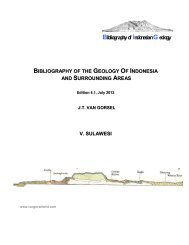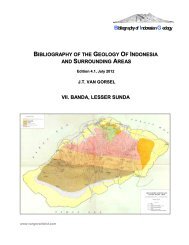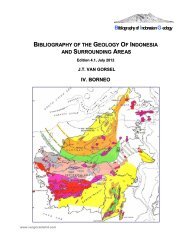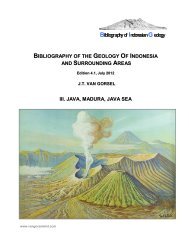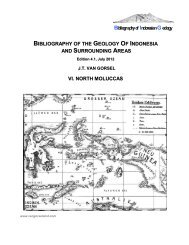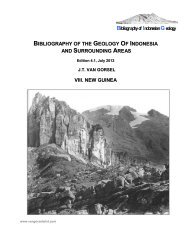Sumatra, Sunda Shelf, Natuna - Bibliography of Indonesia Geology
Sumatra, Sunda Shelf, Natuna - Bibliography of Indonesia Geology
Sumatra, Sunda Shelf, Natuna - Bibliography of Indonesia Geology
Create successful ePaper yourself
Turn your PDF publications into a flip-book with our unique Google optimized e-Paper software.
Barber, A.J. & M.J. Crow (2008)- The origin and emplacement <strong>of</strong> the West Burma- West <strong>Sumatra</strong> ribboncontinent.<br />
In: Proc. Int. Symp. Geoscience Resources and Environments <strong>of</strong> Asian Terranes (GREAT 2008), 4th<br />
IGCP 516 and 5th APSEG, p. 18-21.<br />
(online at http://www.geo.sc.chula.ac.th/<strong>Geology</strong>/Thai/News/Technique/GREAT_2008/PDF/001.pdf)<br />
(Combined W Burma-W <strong>Sumatra</strong> ribbon-continent has Cathaysian E Permian fauna and flora similar to S<br />
China and Vietnam. Evidence suggests it became separated in M-L Permian from E margin <strong>of</strong> Cathaysia as thin<br />
continental sliver and by M Triassic had moved along transcurrent fault system around Indochina into present<br />
position W <strong>of</strong> Sibumasu. In Miocene, two blocks were separated by formation <strong>of</strong> Andaman Sea)<br />
Barber, A.J. & M.J. Crow (2009)- The structure <strong>of</strong> <strong>Sumatra</strong> and its implications for the tectonic assembly <strong>of</strong><br />
Southeast Asia and the destruction <strong>of</strong> Paleotethys. Island Arc 18, 1, p. 8-20.<br />
(From E to W Malay Peninsula and <strong>Sumatra</strong> 3 continental blocks: (1) E Malaya with Cathaysian Permian<br />
fauna and flora; (2) Sibumasu (W Malay Peninsula and E <strong>Sumatra</strong>) with glaciogenic Late Carboniferous-Early<br />
Permian; (3) W <strong>Sumatra</strong>, also Cathaysian. Woyla nappe is intraoceanic arc, thrust over W <strong>Sumatra</strong> block in<br />
mid-Cretaceous. Age <strong>of</strong> Sibumasu- East Malaya collision and destruction <strong>of</strong> Paleotethys Triassic? W <strong>Sumatra</strong><br />
block derived from Cathaysia and emplaced against Sibumasu W margin by dextral transcurrent faulting. E<br />
Malaya block is part <strong>of</strong> Indochina block. W Burma block is extension <strong>of</strong> W <strong>Sumatra</strong> block, from which it<br />
separated by formation <strong>of</strong> Andaman Sea in Miocene. Woyla nappe correlated with Mawgyi nappe <strong>of</strong> Myanmar)<br />
Barber, A.J., M.J. Crow & M.E.M de Smet (2005)- Tectonic evolution. In: A.J. Barber, M.J. Crow & J.S.<br />
Milsom (eds.) <strong>Sumatra</strong>- geology, resources and tectonic evolution, Geol. Soc., London, Mem. 31, p. 234-259.<br />
Barber, A.J., M.J. Crow & J.S. Milsom (eds.) (2005)- <strong>Sumatra</strong>: geology, resources and tectonic evolution. Geol<br />
Soc., London, Mem. 31, p. 1-290.<br />
(Major overview <strong>of</strong> <strong>Sumatra</strong> geology and mineral occurrences)<br />
Barliana, A. (2002)- Oil and gas discoveries in the Baturaja carbonate play, Corridor Block, South <strong>Sumatra</strong><br />
Basin. IPA News Letter, October 2002, p. 12-16.<br />
Barliana, A., G. Burgon & C.A. Caughey (1999)- Changing perceptions <strong>of</strong> a carbonate gas reservoir: Alur<br />
Siwah Field, Aceh Timur, <strong>Sumatra</strong>. Proc. 27 th Ann. Conv. Indon. Petrol. Assoc. IPA99-G-160, p. 1-18.<br />
(1972 Alur Siwah discovery looked like substantial gas accumulation. First few wells gas column >110m in E<br />
Miocene Peutu Lst build up. OGIP estimated at 727 BCFG. Later wells found poor reservoir quality and OGIP<br />
estimates plummeted to 195 BCFG. Subsequent 3D seismic and infill drilling indicates OGIP <strong>of</strong> 717 BCFG)<br />
Barliana, A., T. Wahyudi & M. Chamberlain (1993)- Stratigraphy <strong>of</strong> outcropping Miocene deposits, Aceh<br />
Timur: implications for hydrocarbon exploration. Proc. 22nd Ann. Conv. IAGI, Bandung 1993, 2, p. 814-831.<br />
(N <strong>Sumatra</strong> Block A exposures <strong>of</strong> late Early Miocene Peutu Limestone, forming N-S ridge over 25 km)<br />
Baroek, M.P., T.L. Heidrick & K.D. Kelsch (1999)- Linked tectonics, a powerful new paradigm for deciphering<br />
the structural evolution <strong>of</strong> the Menggala North Field. In: SPE Asia Pacific Oil and Gas Conf., Jakarta 1999,<br />
26p.<br />
(Structural analysis <strong>of</strong> 3D seismic dataset <strong>of</strong> N Menggala field, C <strong>Sumatra</strong>, unraveling deformation patterns<br />
over past 30 Ma. Anticlinal trap formed by inversion <strong>of</strong> S Balam half-graben along N-S-trending S Balam<br />
Border Fault. Three episodes <strong>of</strong> deformation: (F1) Eo-Oligocene(45-28 Ma) transtension, (F2) Late<br />
Oligocene- E Miocene (~28-21 Ma) transpression and (F3) Late Pliocene (3.8 Ma)- Recent compression)<br />
Baroux, E., J.P. Avouac, O. Bellier & M. Sebrier (1998)- Slip-partitioning and fore-arc deformation at the<br />
<strong>Sunda</strong> Trench. Terra Nova 10, p. 139-144.<br />
Bartram, K. M. & L. Nugrahaningsih (1990)- A palynological study <strong>of</strong> the Sawahlunto Formation, Ombilin<br />
Basin, West <strong>Sumatra</strong>. Lemigas Scientific Contr. Petrol. Sci. Techn., Spec. Issue, p. 123-136.<br />
<strong>Bibliography</strong> <strong>of</strong> <strong>Indonesia</strong> <strong>Geology</strong> v. 4.1 12 www.vangorselslist.com July 2012



